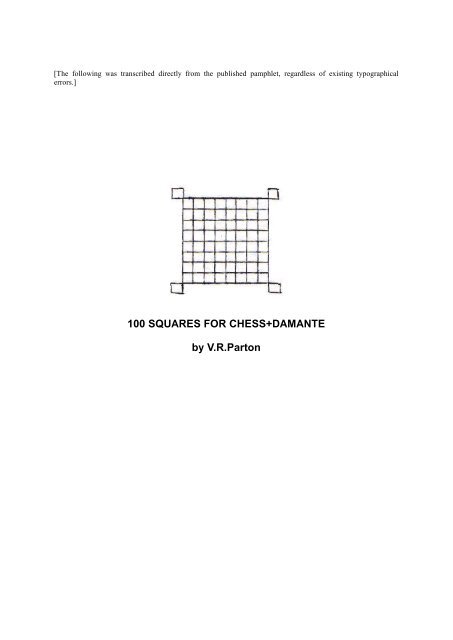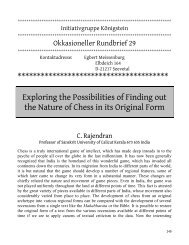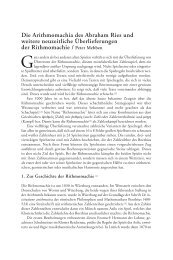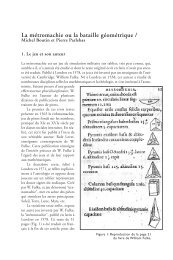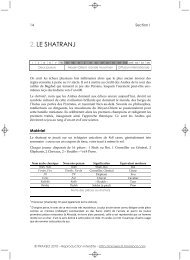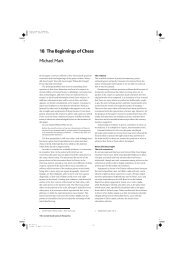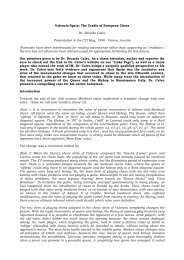100 SQUARES FOR CHESS+DAMANTE by V.R.Parton - History of ...
100 SQUARES FOR CHESS+DAMANTE by V.R.Parton - History of ...
100 SQUARES FOR CHESS+DAMANTE by V.R.Parton - History of ...
You also want an ePaper? Increase the reach of your titles
YUMPU automatically turns print PDFs into web optimized ePapers that Google loves.
[The following was transcribed directly from the published pamphlet, regardless <strong>of</strong> existing typographical<br />
errors.]<br />
<strong>100</strong> <strong>SQUARES</strong> <strong>FOR</strong> <strong>CHESS+DAMANTE</strong><br />
<strong>by</strong> V.R.<strong>Parton</strong>
CAPABLACAN CHESS<br />
Among the chess ideas to which the great player Capablanca gave his serious study and playing, one belongs to<br />
the Decimal field <strong>of</strong> the game. From a theoretical point <strong>of</strong> view, the three "radical moves" in chess are first,<br />
vertical and horizontal moves <strong>of</strong> the Rook; second, diagonal moves <strong>of</strong> the Bishop; and third, skew leap<br />
movements <strong>of</strong> the Horse or Knight. The chess Queen can be regarded as being a piece which combines two <strong>of</strong><br />
these radical moves namely, the orthogonal (Rook) and the diagonal (Bishop) so that the Queen is really the<br />
compound R + B. It is quite logical to have a piece combining the diagonal move and the skew leap, and a piece<br />
combining the orthogonal move and the skew leap.<br />
These two compound types are naturally proper companions for the Queen, as fashioned in the same manner.<br />
The piece moving as Rook and Horse is called "Chancellor" and that moving as Bishop and Horse is called<br />
"Archbishop". (These terms are Capablanca's terms). For playing the Capablancan on the Decimal board, a<br />
player has twenty men consisting <strong>of</strong> his normal pieces and the Chancellor and Archbishop with their pawns. In<br />
the initial arrangement <strong>of</strong> chessmen in the player's rear rank, the position <strong>of</strong> the Chancellor (Rook-Horse) is<br />
between the Bishop and Horse on the King's wing, and that <strong>of</strong> the Archbishop (Horse Bishop) likewise between<br />
the corresponding pieces on the Queen's wing.<br />
The order <strong>of</strong> men in the back rank is thus: R-H-A-B-Q; K-B-C-H-R. The ten pawns are in the 2nd rank.<br />
DECIMAL FALCON-HUNTER (Schulz Chess)<br />
The variant <strong>of</strong> Decimal Chess described in this section is derived from a very original idea due to the<br />
imagination <strong>of</strong> an Austrian player Karl Schulz who invented about 1943 two new kinds <strong>of</strong> chessmen. The<br />
common characteristic <strong>of</strong> these two pieces, which are named Falcon and Hunter, is that they move forward in a<br />
different way to that in which they move backward.<br />
The Falcon moves forward diagonally like the Bishop, but moves backward orthogonally like the Rook; it<br />
cannot move left or right along its rank. The Hunter moves forward vertically like the Rook, but moves<br />
backward diagonally like the Bishop; it has no movement along its rank. These two pieces are complementary<br />
and together form a logical couple, being one another opposite or reverse in type <strong>of</strong> movement. A marked<br />
difference may be noted between the normal pieces, (K, Q, B, H, R) and the Falcon and Hunter, which two<br />
pieces, instead <strong>of</strong> moving in four or eight directions as do the ordinary five types, move in three directions, for<br />
the pattern <strong>of</strong> move made <strong>by</strong> the Falcon may be symbolised <strong>by</strong> the letter Y and the pattern <strong>of</strong> move <strong>by</strong> the<br />
Hunter <strong>by</strong> this letter Y inverted.<br />
The initial position <strong>of</strong> the Falcon on the Decimal board is between the King and his Bishop and that <strong>of</strong> the<br />
Hunter between the Queen and her Bishop. The order <strong>of</strong> pieces in the player's back rank is thus: R - H - B -<br />
Hunter - Q; K - Falcon - B - H - R.<br />
HALF - QUEEN'S CHESS<br />
The general design <strong>of</strong> Half-Queen's Chess resembles closely those <strong>of</strong> the Capablancan and the Schulz variants.<br />
The player's normal chess pieces are augmented <strong>by</strong> the two new types, with corresponding pawns, to raise his<br />
forces to twenty men.<br />
The chess Queen can be regarded as the compound <strong>of</strong> Rook and Bishop. For all that, however, one can hardly<br />
think <strong>of</strong> either piece as being a proper logical form <strong>of</strong> "Half-Queen" because their powers are too unequal and<br />
their patterns <strong>of</strong> move little related. In theory an alternative "halving" for the chess Queen can be established.<br />
When the non-taking moves are completely separated from the capturing moves, then the Queen has four<br />
components in all. It is now possible to combine the diagonal (Bishop) non-taking move <strong>of</strong> the Queen with her<br />
orthogonal (Rook) capturing move into one type, and her orthogonal (Rook) non- taking move with her diagonal<br />
(Bishop) capturing move to the other type. These "Half-sisters" as they might be called <strong>of</strong> the Queen are<br />
consequently the "Biok" which moves like the Bishop for mere change <strong>of</strong> position, but captures like the Rook;<br />
and the "Roshop" which behaves reversely, moving like the Rook for simple change in position, but capturing<br />
like the Bishop. Together these two Half-Queens compound into the Queen.
On the Decimal board, the Biok is initially placed between the King and his Bishop; and correspondingly the<br />
Roshop between the Queen and her Bishop. The order <strong>of</strong> pieces in the player's back rank is thus R - H - B -<br />
Roshop - Q; K - Biok - B - H - R.<br />
DECIMAL ORIENTAL CHESS.<br />
For the game <strong>of</strong> Decimal Oriental the player has an army <strong>of</strong> twenty men which consist <strong>of</strong> two Chariots, two<br />
Cannons, two Horsemen, two Camels and two Elephants, with the Minister and Prince Commander, supported<br />
<strong>by</strong> eight soldiers.<br />
The arrangement <strong>of</strong> pieces in the player's rear rank is Chariot - Cannon - Camel - Elephant - Minister -<br />
Commander - Elephant - Camel - Cannon -Chariot. In the second rank, a Horse is placed immediately in front <strong>of</strong><br />
the Camel in the same file. The eight soldiers are placed on the player's third rank but the squares are not<br />
occupied in the two files (c and h) which each have a Camel and a Horseman.<br />
The Chariot in Decimal Oriental Chess moves like the Rook; the Horseman like the Knight; and the Commander<br />
like the King. Soldiers move and take forward like chess pawns. The Minister moves one square cornerwise<br />
forward or backward. The Elephant has a diagonal move, which consists <strong>of</strong> a leap over an adjacent cornerwise<br />
square, whether occupied or empty, into the next square beyond along the same direction. The Cannon moves<br />
any distance vertically or horizontally, <strong>by</strong> leaping over a piece (called the "screen") in it's path. It can move only<br />
over one piece, which may be either friend or foe; it can capture a foe lying beyond the screen. The Cannon has<br />
no movement nor take except <strong>by</strong> leaping over a "screen". The Camel has a move resembling the Knight's skew<br />
leap; it's move is a slant jump to the cross opposite corner <strong>of</strong> a rectangle 2 x 4.<br />
The aim <strong>of</strong> play in this game is naturally to attack and defeat the enemy Commander.<br />
DECIMAL IMITANTE Q CHESS.<br />
The player for "Imitante Q" adds to his normal 16 chessmen a pair <strong>of</strong> Imitante Q pieces with their attendant<br />
pawns. An Imitante Q is initially placed between H and B on each flank. The order <strong>of</strong> back row pieces R-H-I-B-<br />
Q-K-B-I-H-R. An Imitante Q moves like the Queen, but has no specific take <strong>of</strong> its own, quite unlike chess<br />
pieces.<br />
An Imitante Q captures a foe in exactly the same way as that foe is threatening to capture this Imitante Q itself.<br />
For example, the Imitante Q captures a Rook with a Rook take; it cannot capture that Rook with a Bishops' or<br />
Knights' take as a consequence. These Imitante Q's check the enemy King only when they are <strong>of</strong> course adjacent<br />
to that King, for he only captures adjacently. Naturally an Imitante Q cannot capture an enemy Imitante Q.<br />
CENTAUR ROYAL<br />
For playing Centaur Royal, a player has force <strong>of</strong> twenty-one pieces. This includes two Queens, four Rooks and<br />
four Bishops. Strange as it may seem the player's force has neither a Horseman nor a King <strong>of</strong> the ordinary chess<br />
game included in its type <strong>of</strong> men. The remaining pieces in the player's army are ten Pawns and the Special piece<br />
which is termed "Centaur Royal".<br />
The role <strong>of</strong> kingship is here the task <strong>of</strong> the Centaur, for this reason the title <strong>of</strong> "Royal" being added. The move<br />
which the Centaur makes is the move <strong>of</strong> the Horseman (Knight), not the move <strong>of</strong> the ordinary chess monarch.<br />
Because <strong>of</strong> such form in movement (and taking) the name <strong>of</strong> the mythological Greek creature, partly horse-like<br />
and partly man-like, is quite appropriate as the special name for the "vital piece" or the King equivalent in this<br />
variant <strong>of</strong> Decimal Chess. In actual play these "Centaurs" are conveniently represented <strong>by</strong> Horsemen or Knights.<br />
In the initial arrangement <strong>of</strong> the player's pieces, his ten pawns occupy his third rank, not the second rank. His<br />
Centaur Royal is placed in the left-hand square <strong>of</strong> his second, but no other pieces occupy this rank at the start <strong>of</strong><br />
play. His two Queens, four Rooks and four Bishops are arranged along his back rank as follows: R-R-B-B-Q-Q-<br />
B-B-R-R.<br />
The player's aim is naturally to attack and capture the enemy Centaur Royal while defending his own Centaur<br />
from danger. Attempting to capture a piece moving about with skew jumps like a Horse creates play very
different from attacking a piece that can move only one square at a time. The variation <strong>of</strong> Double Decimal<br />
Centaur has the same arrangement <strong>of</strong> pieces as that already described, but a second Centaur Royal is added to the<br />
player's force, this second being placed in the right-hand square <strong>of</strong> his second rank. Capture <strong>of</strong> both enemy<br />
Centaurs wins the game.<br />
DAMATE GAME<br />
The essential idea on which my Damante Game is founded may be roughly described as the variety <strong>of</strong> draughts<br />
(checkers) which is played with "chessmen" on all the squares both black and white <strong>of</strong> the decimal board, instead<br />
<strong>of</strong> only on the system <strong>of</strong> one colour <strong>of</strong> the board. The Damatic is my idea <strong>of</strong> that modern, augmented and<br />
diversified decimal form into which the simple basis <strong>of</strong> ordinary draughts can be extended and developed in a<br />
quite natural and logical manner.<br />
In chess each <strong>of</strong> the types <strong>of</strong> pieces moves in a different way; it is clear that such good variety in pieces can<br />
provide much depth and wealth for opening and developing play, for combinational and strategic play. In its<br />
character the idea <strong>of</strong> this Damatic Game is essentially the adding and blending with the general elements basic to<br />
draughts, <strong>of</strong> a nearly equivalent and similar variety in pieces to gain like depth and richness in the Damatic play.<br />
A Damate, as a piece in this game is specifically named, captures in a manner similar to that mode <strong>of</strong> capture<br />
used in draughts, and not as pieces take in the game <strong>of</strong> chess. The correspondence between damatic types and<br />
varieties <strong>of</strong> chessmen is:- King, minor damate, can move one square in any direction from its position, and can<br />
take a foe situated on some neighbouring square <strong>by</strong> leaping over its foe into the first square, if vacant, on the<br />
other side <strong>of</strong> its captive. [Note from transcriber: In the preceding paragraph, the phrase "first square," was<br />
originally typed as "third square," and hand-made corrections were applied to form its present reading. The 'h'<br />
in 'third' was over-written with an 'f', the 'd' was over-written with an 's' with the letter 't' tagged to the end.<br />
Although the 't' in the original word 'third' was not deleted, it was felt that its exclusion in this transcription<br />
would only increase clarification to the reader.]<br />
In other words, this minor damate captures like the crowned piece in ordinary draughts, but it can do so both<br />
horizontally and vertically as well as cornerwise. The taking move in which a damate captures an adjacent foe <strong>by</strong><br />
leaping over this enemy into the first square beyond (if vacant) is termed "short take". Rook, orthogonal damate,<br />
can move any number <strong>of</strong> squares in either vertical or horizontal directions from its position. The orthogonal<br />
damate can capture an isolated foe in its path (either vertical or horizontal) even when empty squares separate if<br />
from the foe, and it may leap to any vacant square on the other side <strong>of</strong> its captive in that same direction. Bishop,<br />
diagonal damate, can move any number <strong>of</strong> squares in a diagonal direction, either forward or backward, from its<br />
position. The diagonal damate can take an isolated enemy in its diagonal path, even if separated from its foe <strong>by</strong><br />
empty squares; and it may leap to any vacant square on the opposite side <strong>of</strong> its captive along that same diagonal<br />
line. The extended taking move <strong>by</strong> which orthogonal and diagonal damates can capture enemy pieces is termed<br />
"long take", for clear distinction from the "short take". Queen, major damate, has the powers <strong>of</strong> both diagonal<br />
and orthogonal damates.<br />
Pawn, advancing damate, can step one square either straightforward in its column or cornerwise forward; it can<br />
capture a foe adjacent in front (whether cornerwise or straight in front) with a "short take". As in ordinary<br />
draughts, taking is compulsory in this game; and a piece can make a continued (multiple) take, when <strong>by</strong><br />
capturing one foe it comes to a square from which it can take another enemy.<br />
The aim <strong>of</strong> play in Damate is to capture all the enemy pieces whatever they are. At first thought, a damate with<br />
the move <strong>of</strong> the chess knight may appear awkward to introduce into damatic form. Such H damate makes a<br />
"double knight move" over its foe in capturing this. For example, situated on square b3, this H damate, can<br />
capture a hostile piece on square c5, <strong>by</strong> leaping over that foe to square d7 (if vacant); or an enemy on square d2,<br />
<strong>by</strong> leaping over it to square f1. It will be seen that b3. c5, d7 are in a straight line, and likewise b3, d2, f1. The<br />
chess knights can be used to represent pieces in Damate which cannot move or take, but which can be captured.<br />
Such Z damate (Z = zero, stationary) will avoid the awkwardness <strong>of</strong> the H damate (H = Horse, Knight) as<br />
players may at first prefer to exclude H damates altogether.<br />
For playing on the Decimal board, a player should have two each <strong>of</strong> Q (major), K (minor), R (orthogonal), B<br />
(diagonal), H or Z, with ten P (advancing) damates. The pieces in the player's rear rank are arranged as follows -<br />
R - B - H - Q - K - K - Q - H - B - R with ten pawns in his second rank. (Two extra pawns may be added<br />
centrally in 3rd row) An advancing damate (P) moving across the central line into the enemy side or half <strong>of</strong> the<br />
Decimal board is promoted into major damate.
DAMATIC CHESS.<br />
The games <strong>of</strong> Capablancan, Schulz (Falcon-Hunter) and Half Queens already described can easily be given<br />
corresponding damatic forms. For the Schulz game, the damatic equivalent <strong>of</strong> the Falcon naturally moves and<br />
takes forward like the diagonal damate, but backwards in its column like the orthogonal damate; whereas the<br />
equivalent <strong>of</strong> the Hunter move and takes straight- forward like an orthogonal, but backwards like the diagonal.<br />
The damatic King moves and takes like a minor damate; and capturing the enemy monarch (damatic King) wins<br />
the game.<br />
The corresponding damates to the Archbishop and Chancellor in the Capablancan are those combining the H<br />
damate respectively with the diagonal and orthogonal damates. In the case <strong>of</strong> the Biok and Roshop in Half<br />
Queens, the idea <strong>of</strong> a piece moving diagonally but taking orthogonally, and that <strong>of</strong> a piece moving orthogonally<br />
but taking diagonally, are both easily given their respective damatic form. In the Schulz and Half Queens<br />
equivalents in Damatic Chess, it may be convenient to treat chess knights as Z - damates, stationary on their<br />
squares until captured.<br />
The aim <strong>of</strong> the player in Damatic Chess is to attack and capture the hostile damatic king, any other enemy<br />
damates captured in the struggle being <strong>of</strong> secondary importance or value. The player wins this game immediately<br />
he captures the enemy damatic king. Advancing damates (pawns) may be allowed to promote when they have<br />
moved across the central line into the enemy half or side <strong>of</strong> the Decimal board. As only one piece is the vital<br />
target <strong>of</strong> attack, games <strong>of</strong> Damatic Chess will be shorter, and easier to understand in general, then games <strong>of</strong><br />
Damate itself requiring capture <strong>of</strong> all enemy pieces for victory.<br />
DECIMAL DUFFERS' CHESS.<br />
Perhaps the real difficulty for a Decimal Duffer is that he has far too wide in choice <strong>of</strong> moves in playing Decimal<br />
Chess variants. He has as it were rather a banquet instead to have digestive biscuits to eat chessically!.<br />
In order to prevent the Decimal Duffer having chessical sickness through over-rich food, the idea explained in<br />
this chapter reduces DC to a simple meal <strong>of</strong> moves permitted in play. The initial arrangement <strong>of</strong> pieces used in<br />
playing the Capablancan, Schulz, or Half Queens variant may be used for playing Decimal Duffers' Chess.<br />
• First, if one <strong>of</strong> the player's chessmen can make a check on the enemy King, then he may make that<br />
checking move. Between two or more ways <strong>of</strong> checking, the player has a choice.<br />
• Secondly, if one <strong>of</strong> the player's pieces can take an enemy, then that capturing move may be made but the<br />
player has <strong>of</strong> course a choice between two ways <strong>of</strong> taking which occur at the very same turn.<br />
• Thirdly if the player can make neither a check not a take with any <strong>of</strong> his chessmen, then he must play<br />
only some pawn in his force.<br />
• Fourthly, if his King should be in check, the player is permitted to move this King out <strong>of</strong> check.<br />
Capturing a hostile piece that gives check is <strong>of</strong> course allowed under the first rule stated above. Moving a piece<br />
between the player's own King and a checking enemy is not permitted, except in the case <strong>of</strong> a pawn, allowed <strong>by</strong><br />
the third rule. Also it is clear that castling cannot be used in Decimal Duffers' Chess.<br />
WYVERN CHESS.<br />
The game <strong>of</strong> Wyvern is played on the Decimal board. Besides his normal sixteen chess pieces the player has a<br />
pair <strong>of</strong> chessmen called Wyvern, with their corresponding pawns to complete the pawn row. (Wyverns may be<br />
represented <strong>by</strong> Rooks inverted.)<br />
The position <strong>of</strong> a Wyvern is between those <strong>of</strong> Horse and Bishop in the rear rank, so that in the player's back row<br />
the order <strong>of</strong> men is R - H - W - B - Q - K - B - W - H - R A Wyvern is the most powerful <strong>of</strong> the pieces, for a<br />
Wyvern can move, take and check like Rook, Bishop and Horse from its position.
DABBABANTE CHESS.<br />
In this Decimal game <strong>of</strong> chess the player adds to his normal force <strong>of</strong> chessmen a pair <strong>of</strong> special pieces called<br />
Dabbabante, with their pawns. In the initial arrangement <strong>of</strong> the pieces on the Decimal board the player's ten<br />
pawns occupy his third rank. The other pieces are arranged on his second rank in the following order R - H - D -<br />
B - Q - K - B - D - H - R. His rear rank is thus not occupied <strong>by</strong> chessmen at the opening <strong>of</strong> play.<br />
The special piece Dabbabante moves in vertical and horizontal directions, but never in diagonal directions. A<br />
Dabbabante can move only to squares <strong>of</strong> the same colour in its rank or file. If it is initially on a white square,<br />
then a Dabbabante will always move to white squares in its file or rank. Also, a Dabbabante can move over<br />
occupied squares in its orthogonal path; these occupied squares may be either black or white, and pieces<br />
occupying such squares can be friendly or hostile. A Dabbabante can capture an enemy in its file or rank,<br />
provided <strong>of</strong> course that this Dabbabante and its enemy are standing on squares <strong>of</strong> the same colour. A Dabbabante<br />
in the same rank or file as the enemy King checks that monarch only if they are both on squares <strong>of</strong> the same<br />
colour.<br />
The check <strong>of</strong> the Dabbabante on the King is not obstructed <strong>of</strong> course <strong>by</strong> any piece situated between these two. A<br />
large part <strong>of</strong> the Dabbabante's value is due to there being no defence <strong>by</strong> intervention against attacks and checks<br />
which it makes. In the early stages <strong>of</strong> the game when the forces have lost very few men, Dabbabantes have their<br />
best chances to destroy the enemy defences and to drive the enemy King into an awkward position. It will be<br />
seen that a Dabbabante is limited to movements on only a quarter <strong>of</strong> the total squares <strong>of</strong> the board,<br />
This new type <strong>of</strong> chessmen, the Dabbabante, is my special "extension and expansion" <strong>of</strong> the old chess piece<br />
called Dabbaba. The diagonal similar piece to this Dabbabante is <strong>of</strong> course named the Alfilante, being like<br />
"extension" <strong>of</strong> the old chess piece called the Alfil. The power <strong>of</strong> the Dabbabante may be increased <strong>by</strong> its<br />
combining with the "A" type <strong>of</strong> movement, but this "compound Dabbabante" is still limited to movements on the<br />
same square system as the proper Dabbabante.<br />
DECIMAL BUTTER<br />
The arrangement <strong>of</strong> pieces used for the Capablancan, Schulz Tweedle or Wyvern games can be used for playing<br />
Decimal Butter. In this game the pieces (called Butters) capture enemy pieces neither like chessmen not like<br />
draughtsmen.<br />
A Butter strikes at any foe <strong>by</strong> "butting" that foe which is sent flying <strong>of</strong>f the Decimal board and out <strong>of</strong> the game.<br />
A Butter moves to some square adjacent to a foe in order to give that foe a "butting". Should a Butter rush to a<br />
square adjacent to several enemies, then they are all "butted" together and so must be removed together <strong>of</strong>f the<br />
board. The player's aim is to "butt" every enemy <strong>of</strong>f the board as quickly as possible.<br />
DECIMAL OBSTACLES CHESS<br />
The arrangement <strong>of</strong> pieces used for the Capablancan, Schulz, Tweedle or Wyvern can be used for playing<br />
Decimal Obstacles. The rules are very simple. Pieces can only advance; there is no taking, and no checking in<br />
this game. The aim <strong>of</strong> the player is to advance one <strong>of</strong> his pieces into the enemy rear rank before his opponent can<br />
do so. The pieces are really "obstacles" in character to prevent an enemy penetrating through their lines to reach<br />
the desired goal.<br />
Naturally a player has to be very careful how he moves a piece from his rear rank, thus opening a square for an<br />
enemy to advance into later. Pawns* will <strong>of</strong> course remain in their own files, and so will have small chance to<br />
reach the enemy back row. Rooks cannot get into that back rank being obstructed <strong>by</strong> the pawns in the same file.<br />
Clearly the Queen is the most likely to reach the enemy rear line first, if the Schulz or Tweedle arrangement <strong>of</strong><br />
pieces is used for Obstacles Chess<br />
*Pawns can take enemy pieces.
CHIMAERA<br />
For playing the Chimaera idea <strong>of</strong> Decimal Chess, the player's force includes a pair <strong>of</strong> special pieces to which the<br />
name <strong>of</strong> the Greek mythological monster, Chimaera, has been given. In the initial arrangement <strong>of</strong> pieces on the<br />
Decimal board, the position <strong>of</strong> a Chimaera is between Horse and Bishop, one placed on the Queen side and the<br />
other on the King side <strong>of</strong> a player's force. (Chimaeras may be represented <strong>by</strong> Rooks inverted or <strong>by</strong> draughtsmen<br />
for practical convenience)<br />
A Chimaera moves like the Queen, any distance diagonally or orthogonally when changing position. A Chimaera<br />
cannot take, but also it cannot be captured <strong>by</strong> any hostile piece whatever. Moreover, as it cannot take, the<br />
Chimaera cannot give check <strong>of</strong> any kind on the enemy King even when they are adjacent or are in open line<br />
either diagonally or orthogonally with each other. The special power <strong>of</strong> the Chimaera is that when it appears to<br />
be attacking a foe, this Chimaera can interchange positions with that foe!<br />
That is, the Chimaera is like an imitation <strong>of</strong> a Queen that can occupy its victim's square, not making a capture<br />
but instead forcing its victim to transfer to that very square which has just been quitted <strong>by</strong> the Chimaera itself.<br />
Chimaeras <strong>of</strong> opposing forces are naturally not able to capture each other, but they are instead able to<br />
interchange their squares. The menace <strong>of</strong> the Chimaera on the enemy King is obviously that this unfortunate<br />
monarch may suddenly find himself flying as it were across the board into the very midst <strong>of</strong> his enemies, <strong>by</strong> such<br />
interchange <strong>of</strong> positions forced <strong>by</strong> the monster on this very miserable feeble King. Also a pawn acting as a shield<br />
before its own King may be sent flying away from its position <strong>of</strong> defending its King <strong>by</strong> an enemy Chimaera,<br />
suddenly and unexpectedly leaving the monarch exposed in the open to forthcoming assault.<br />
As the Chimaeras are untakeable, they remain in play on the Decimal board until one <strong>of</strong> the players can succeed<br />
in checkmating the enemy King.<br />
GORGONA<br />
For playing this variant <strong>of</strong> Decimal Chess, a player adds to his normal force <strong>of</strong> sixteen chessmen a pair <strong>of</strong> special<br />
pieces called "Gorgona" with corresponding pawns. The initial square <strong>of</strong> a Gorgona is between those <strong>of</strong><br />
Horseman and Bishop on the same wing <strong>of</strong> the player's force.<br />
Consequently, the order <strong>of</strong> pieces in the player's back rank is as follows R - H - G - B - Q - K - B - G - H - R,<br />
with a line <strong>of</strong> ten pawns in front. (It is very convenient to represent Chimaera <strong>by</strong> inverted Rooks or even <strong>by</strong><br />
draughtsmen). [Note from transcriber: At the end <strong>of</strong> the preceding paragraph, there is a reference to the<br />
"Chimaera". Obviously, that word should read "Gorgona".]<br />
A Gorgona moves like the Queen but cannot capture at all. Instead, a Gorgona has the special power to "petrify"<br />
any hostile piece on which its gaze falls directly; that is, such enemy being petrified <strong>by</strong> a Gorgona is completely<br />
unable to move or even take as long as it is facing this Gorgona's gazing attack. Should later this Gorgona move<br />
to a new position where it no longer gazes on that particular foe, then <strong>of</strong> course that foe becomes quite free to<br />
move and take once again in its normal manner. If some piece, whether friend or foe, comes between a Gorgona<br />
and its petrified enemy, such spell is at once broken and that foe will regain its freedom <strong>of</strong> normal movement.<br />
It is understood that the King when petrified <strong>by</strong> a hostile Gorgona is not able to move from his square, not even<br />
if this monarch is actually in check! When the very probable situation arises where a Gorgona is gazing directly<br />
at a hostile rival Gorgona, then it results logically that both are mutually petrified and neither Gorgona is able to<br />
move from its position. In such position, even though two Gorgonas <strong>of</strong> opposing forces have immobilised one<br />
another, each will still petrify any hostile piece in open line with its gazing attack. The vulnerable spot in the<br />
Gorgona's power is that Horsemen (Knights) can capture them for obviously a Horseman <strong>by</strong> its skew jump<br />
movement in taking the enemy Gorgona is not in open straight line with the monster.<br />
One particular point needs perhaps to be clarified. A piece that is petrified <strong>by</strong> a Gorgona is not <strong>of</strong> course able to<br />
move to take, consequently that petrified piece makes no checking whatever on the enemy King though the<br />
position appears to be so. Immediately the petrified becomes "dispetrified", then the position will really become<br />
a check on that King. On the Decimal board the chess Knight (Horse) has rather less power than on the ordinary<br />
8 X 8 board; but in Gorgona this piece has at least one advantage over all others, for the Horse is the only<br />
chessman able to capture the Gorgonas. Terrible even more is the "Terrible Gorgona" that can take as well as<br />
petrify its victims.
CIRCEAN<br />
The idea <strong>of</strong> Circean is probably the most fantastic form <strong>of</strong> Decimal Chess. Though the player begins this game<br />
with a force <strong>of</strong> twenty pieces, they are all pawns!<br />
Initially, ten pawns occupy the player's back rank and the other ten occupy his third rank. When a player<br />
advances one <strong>of</strong> his pawns, on its new square it will become a completely different sort <strong>of</strong> piece, namely a<br />
Knight! The general idea in this game is that when a piece moves or takes, it not only changes its squares, but<br />
also its very nature at the same time, just because it is Circean, a chessman which that Greek sorceress Circe<br />
might have "enchanted". Should the player move a Knight, this piece becomes on its new square a Bishop; in<br />
like fashion a Circean Bishop changes into a Rook and a Circean Rook into a Queen. Finally, on moving to a<br />
new square a Circean Queen changes her gender and becomes a King instead!<br />
Briefly, the rule <strong>of</strong> change in Circean pieces is P - H - B - R - Q - K, this order <strong>of</strong> change being the ranking <strong>of</strong> the<br />
importance <strong>of</strong> the pieces themselves. When at last a Circean piece has reached the status <strong>of</strong> kingship, this piece<br />
must remain a "plain" King till the end <strong>of</strong> the game. In consequence, a player may find himself in time the proud<br />
possessor <strong>of</strong> several Kings! Should any one <strong>of</strong> those Kings be checkmated, then this Circean game is <strong>of</strong> course<br />
lost to their player.<br />
Certain limitation is placed on the number <strong>of</strong> knights, bishops etc., which the player is allowed to have on the<br />
Decimal board at the same time. He may not have more than four knights; bishops (or rooks) are restricted to<br />
three (and queens to two) <strong>of</strong> their own kind. If the number <strong>of</strong> pawns in a player's rear rank are reduced from ten<br />
down to just a single pawn, then obviously it is easy to play Circean!<br />
AMBI-CHESS (L and R)[TWEEDLE]<br />
The game <strong>of</strong> Ambi-Chess is my special variant <strong>of</strong> the chessical idea in which a player at each turn is required to<br />
move two <strong>of</strong> his pieces, not just one as is customary. For playing this Decimal Ambi-Chess a player requires a<br />
second King and second Queen with their corresponding pawns. The pieces in the player's rear rank are initially<br />
arranged as follows R - H - K - B - Q; Q - B - K - H - R (the letter H meaning Horse or Knight) with the ten<br />
pawns placed in the third rank.<br />
The chessmen in the left-hand half <strong>of</strong> the player's force must be clearly distinguished in some manner from those<br />
in his right-hand half. The chessmen in his left half-force can very conveniently be pieces <strong>of</strong> a larger size that<br />
those in the right. (such distinguishing sign may also be shown <strong>by</strong> fixing a coloured elastic band or coloured<br />
thread or paper round the left half chessmen) The two half-forces may be termed L and R chessmen.<br />
When the player has his turn to move in Ambi-Chess, he must move two <strong>of</strong> his pieces before the opponent can<br />
play. First the player must move one <strong>of</strong> his L or left half pieces; and then one <strong>of</strong> his R or right half pieces. He<br />
cannot play two pieces belonging to the same half-force. The player's aim in Decimal Ambi-Chess is naturally to<br />
checkmate one <strong>of</strong> the two hostile monarchs, which one <strong>of</strong> them not being important.<br />
DECIMAL SCACI PARTONICI<br />
For playing the game <strong>of</strong> Scaci <strong>Parton</strong>ici on the Decimal board, a player has a force <strong>of</strong> twenty chessmen,<br />
consisting <strong>of</strong> two Kings and two Queens, and four each <strong>of</strong> Rooks, Bishops, Horsemen (Knights) and Pawns.<br />
Initially no pieces occupy the player's back rank; in his second rank the ten pieces are arranged P - R - H - B - Q<br />
- K - B - H - R - P; and the ten other pieces are similarly arranged in the player's third rank.<br />
In playing this game all the pieces as well as the pawns are strictly limited to their advancing movements until<br />
they may reach the enemy back rank where such pieces are "promoted", so gaining their complete chess moves.<br />
The object <strong>of</strong> play in "partonici" is to capture hostile pieces. The manner <strong>of</strong> taking in partonici games is a rather<br />
unusual idea, not at all like the mode employed in Chess and Damate for capturing enemy pieces.<br />
(I) A player captures an enemy with a simple partonic take when he moves one <strong>of</strong> his men to a vacant<br />
square adjacent to the foe, <strong>by</strong> which there is already another man <strong>of</strong> this player's force standing<br />
adjacent, so that now the enemy piece is situated between both <strong>of</strong> his men. The three pieces involved<br />
must lie in a straight line but the direction <strong>of</strong> this row can be vertical, horizontal or diagonal. The piece<br />
so held or gripped between its two foes is now a captive <strong>by</strong> this simple partonic take, and is therefore
emoved from the board. In the horizontal direction the position <strong>of</strong> these three pieces will <strong>of</strong> course be<br />
either WBW or BWB.<br />
(II) The contrary idea to the simple partonic take produces the mode <strong>of</strong> taking termed the contrary partonic<br />
form <strong>of</strong> capture. Here it is not the piece between its two foes which is captured, but those two foes<br />
themselves between which it is moved that fall victims in this contrary partonic take.<br />
(III) In the mode termed the line partonic take, the idea <strong>of</strong> partonic is extended so that a straight line <strong>of</strong> two,<br />
three or more enemy pieces will become capturable together at a single turn. Instead <strong>of</strong> just only one foe<br />
between two <strong>of</strong> the player's men, now two or more enemies lie in a straight line between his two men,<br />
where<strong>by</strong> this line partonic position <strong>of</strong> attack is formed. Those two or more foes thus held or gripped<br />
between the player's two men are captives <strong>by</strong> such line partonic, and must therefore be removed<br />
together <strong>of</strong>f the board.<br />
(IV) Naturally the line partonic capture just explained has its own contrary form in similar manner as the<br />
simple partonic has its contrary. In this line contrary partonic take, the player attempts to form a straight<br />
row in which two or more <strong>of</strong> his men will be situated between two enemy pieces. By such contrary line<br />
partonic attack, the player will thus capture those two hostile pieces, one at each end <strong>of</strong> the line so<br />
formed. The player capturing the larger number <strong>of</strong> enemy pieces <strong>by</strong> means <strong>of</strong> partonic takes will gain<br />
the victory.<br />
A player who has "promoted" four (or five) <strong>of</strong> his men and has captured more pieces than his opponent, may<br />
claim the victory at once, if it is obvious that his opponent could not equalise within five moves more from that<br />
position. When a move makes two or three partonic captures at the same time, all the enemy pieces involved in<br />
these attacks are <strong>of</strong> course removed <strong>of</strong>f the board; such a capture is termed a "compound or mixed" partonic<br />
take. Extra pawns may be added to a player's force <strong>by</strong> placing six pawns in the middle <strong>of</strong> his back rank.<br />
Original text <strong>by</strong> Vernon Rylands <strong>Parton</strong>, 1971.<br />
Edited <strong>by</strong> Jean-Louis Cazaux, December 2001, from a text transcripted <strong>by</strong> L. Lynn Smith, kindly transmitted <strong>by</strong><br />
Dan Troyka.


